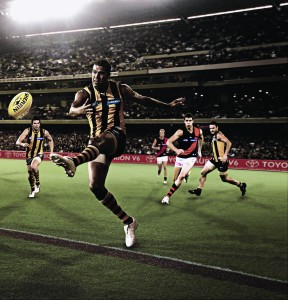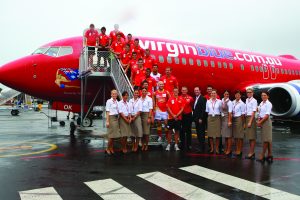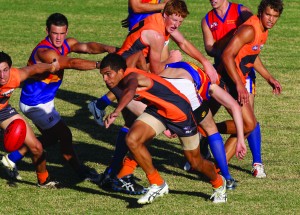A tale of two cities
Share
In the pitiless land of sports marketing, there’s no greater challenge than pulling a new team, sans history, out of your hat. Jeremy Loadman looks to the fortunes of the AFL’s two newest ‘franchises’ – the Gold Coast Suns and the Greater Western Sydney Giants.
On 28 May the Australian Football League’s (AFL) newest team, the Gold Coast Suns, will run out under lights onto the turf of its new state-of-the-art stadium in Carrara. With stands packed full of supporters, and just about every AFL fan in the country watching on television, it will be genuinely exciting. At the ground, AFL heavyweights will allow themselves to relax for the evening, knowing full well that lessons from the past have been learned and this new side will bear few of the burdens suffered by the last Queensland team to play at Carrara, the Brisbane Bears. Unlike the Bears, this new side will have every opportunity to make its mark on the AFL competition. The AFL top brass will know, however, that performance on the park will be the real acid test. If the Suns can bring on-field success to the precision planning that has been carried out by the AFL and Suns administrators, the club will reshape the sporting culture of the Gold Coast region and the Australian sporting landscape. This is how the plan goes anyway.
While the entrance of the Gold Coast Suns into the AFL was first announced by AFL CEO Andrew Demetriou in early 2008, it is arguable that the seeds of this team were first sewn way back in 1990 when the league transformed itself from the VFL (Victorian Football League) to the AFL to reflect its national ambitions. With teams having been established in Sydney, Perth and Brisbane throughout the 1980s and in Adelaide in 1991, the AFL had teams in every state, bar Tasmania. The national competition was starting to take shape – geographically at least.
But while the Perth-based West Coast Eagles and South Australia- based Adelaide Crows emerged to ready-made fan bases, the Brisbane and Sydney sides had no such luxury. Reeling from poor performances and financial distress for many a year, the two sides struggled for relevancy in their respective markets. The plight of these two sides provided the AFL with plenty of headaches, but they also provided it with many valuable lessons about the way in which to market the game in these two locations.
And so with the unveiling of the Gold Coast Suns, followed by GWS in 2012, the AFL will look much more like the truly national competition its administrators crave. There are, of course, many risks attached to these expansion efforts, but in its re-entrance into the New South Wales and Queensland markets, the AFL has come with a highly sophisticated road- map to make sure that mistakes of the past are not recommitted.
LESSONS FROM HISTORIES PAST
It would not be surprising to learn that when the AFL sat down to plan how it would develop new sides on the Gold Coast and in Greater Western Sydney, it looked back at the original development of the Sydney Swans and Brisbane Bears and moved not to repeat a single thing. Quite simply, any book published on modern sports administration and marketing techniques may want to use the early years of these two clubs as a guide of what not to do.
Despite the obvious problems the clubs faced in entering a sports market dominated by rugby league, this was not helped by the decision of the AFL to go down the route of private ownership and sell these clubs to wealthy entrepreneurs, who appeared to have more interest in making money than developing strong and vibrant football clubs.
In 1985, medical entrepreneur Dr Geoffrey Edelsten purchased the Sydney Swans and in 1986 the licence for the Brisbane side was sold to the then massively wealthy Christopher Skase. While these two men provided the cash to sustain the fledgling clubs in their beginnings, from the outside the clubs appeared little more than rich boys’ toys. Supporters were happy to engage with the teams when the good times rolled, but there was no genuine affinity to keep them coming back when things soured.
To their credit, both new clubs and the AFL have put measures in place so that the turmoil that surrounded the Swans and Bears during the early to mid-90s does not repeat itself in coming years.
Dale Holmes, CEO of the GWS Giants, while not privy to how the Swans was run in its initial years, is of the opinion that the Swans marketing model was more superficial in substance. “In a sense, it was trying to bring a follower to the game through entertainment,” says Holmes. While not denying that providing entertainment is crucial for a football club to build a following, Holmes believes the Swans’ early focus on the game as a form of entertainment may have been at the expense of trying to communicate with fans at a more emotional level. And Holmes and his team are well-aware that the process of gaining an emotional connection with fans has become far more specialised than in the days of the Swans.
“Today, there’s far more rigour and science and sophistication around the ongoing communication and engagement of fans to get them to feel an emotional connection with the club,” states Holmes. “So, while we will have an above the line marketing campaign, we will certainly spend a far greater weight of our effort in terms of some of the ongoing communication and engagement strategies we run to get people to support the club.” Improved marketing strategies are one thing, but the AFL is under no illusions about what it will take for these new clubs to truly establish themselves. In a word: success. To help, almost to the point of guarantee- ing it, the AFL has practically delivered the best youth in the country to the Gold Coast by allowing it to pick the eyes out of the national draft, in addition to allowing it to directly sign uncontracted players from other clubs – a process that enabled it to obtain its captain, Gary Ablett. This year, the practice will repeat itself, as GWS gets its turn.
ACTING FAST
Before the Gold Coast and GWS kick a ball in their first AFL matches, they will both have had close to three years to properly establish themselves off-field. While this is clearly a substantial amount of time to set up the basic mechanics of a football club, in terms of branding a club, it is not very long at all.
As such, prior to entering rugby league heartlands, both the Gold Coast and GWS knew they had to make a splash to mark their arrival on the scene. And a splash they did make when they announced they had signed rugby league stars Karmichael Hunt (Gold Coast) and Israel Folau (GWS) on multimillion-dollar contracts. It has been a long standing debate in AFL circles whether an athlete from another sport could switch codes and make it as an AFL player. Realising the publicity that would result from a cross-code defection, Dave Matthews – the AFL’s general manager of market development – really got the ball rolling on the move to entice Hunt and Folau across.
However much necessary publicity the move generated and, as a result, increased levels of brand awareness, it is yet to be seen whether the pair actually have what it takes to make it in the AFL. If they don’t succeed, it will be very interesting to see how the two clubs handle it from a brand management perspective.
Despite the marketing coups of signing Hunt and Folau, it will not be lost on the marketers at the Gold Coast and GWS that many of the biggest AFL clubs have created their identities and brands around histories that date back over 100 years. Unlike other industries, in the football world, where tradition is everything, the word ‘old’ certainly does not equate to being stuffy.
For the new ‘franchises’, the absence of any history or tradition obviously requires the branding process to find other ways into people’s hearts and minds, and quickly. In a congested and ruthless sporting landscape there is no time to let a brand gradually emerge; it has to be defined from the outset.
Administrators and marketing officials at both new clubs will, however, take some heart from the success stories that have been some of Australia’s newest sporting franchises. The Melbourne Victory, which plays in the A-League (soccer), has built up a loyal body of fans and regularly attracts strong crowds to its home games. The Melbourne Storm has also managed to carve itself out a place in the Melbourne sporting landscape; though the effect on its support base of the stripping of the club’s two premierships because of salary cap breaches is yet to be fully seen.
These success stories demonstrate that strong and vibrant brands can be created without a catalogue of historical achievements; they are also reminders that the Australian sporting landscape is filling up, and fast. New sporting franchises seem to be popping up all over the place. Melbourne now has a Super 15 outfit – the Melbourne Rebels. Cricket Australia will this year launch a new eight-team T20 competition and last year a new Australian baseball league was formed. In addition to this, the A-League is still relatively young and many clubs are still finding their feet.
The risk for both the Gold Coast and GWS is, being located in rugby league heartlands, if they don’t establish themselves and their brand in their respective communities fast enough, they face the prospect of being marginalised.
For the two new clubs, this challenge, while difficult, is made a whole lot easier through the support of the AFL, which is armed to the teeth dollar- wise. Additionally, the Gold Coast team has reaped funding grants from the Gold Coast City Council ($20 million) and federal and state government ($86 million) to build a 25,000-seat stadium on the Gold Coast.
Taxpayer funding was forthcoming due to an independent assessment that showed the Gold Coast Suns has a potential to generate up to $32 million per annum for the local Gold Coast economy. The assessment states that the Suns could attract up to 4000 fly-in visitors per match, many of whom may stay in the area longer for either business or pleasure.
With the hope that many fans will combine a football trip with a holiday, the Suns has managed to attract strong national partners, who have a major interest in the tourism sector. Host Plus – the industry superannuation fund for the hospitality, tourism, recreation and sport industries – and Virgin Blue, have both signed on as the club’s major sponsors.
In Western Sydney, it is estimated that the AFL will spend $120 million over a six-year period in order to establish the presence of GWS and AFL in general.
Having plenty of cash to spend does not, however, automatically lead to the creation of a strong identity and vibrant brand. The examples of the Brisbane Bears and the Sydney Swans from their early years demonstrate this in spades. In an increasingly competitive sporting environment, it is all too obvious that only clubs that genuinely engage with
their communities will develop deep-seated loyalty among their fans – the hallmark of any strong brand.
BRANDING VIA COMMUNITY CONSULTATION
At the very beginning of the creation of the two new clubs, their administrators would have sat down and asked themselves the simple question of ‘what does this club stand for?’ In a bygone era, this question may have appeared straightforward (being competitive, making finals, winning premierships etc…). In the contemporary sporting landscape, this is simply not enough. Sporting clubs that are insular and do not embrace wider community ideals miss out on vital opportunities to connect with the public and, if they do happen to hit troubled waters, often find themselves quickly isolated. In short, football clubs (and clubs of all sports for that matter) need to stand for something else besides winning on the weekend.
Travis Auld, CEO of the Gold Coast Suns, describes the brand building process (or developing his club’s ‘personality’ as he terms it) as the club’s most difficult challenge thus far. As a former chief operating officer with the Essendon Football Club – one of the powerhouse clubs of the AFL – Auld has no shortage of understanding of the place football clubs can hold in people’s lives and, as such, knows full well the importance of engagement to the process of building loyalty. With the help of agency Sapient Nitro, the Suns engaged a range of stake- holders from fans, members, community groups, media organisations, sponsors, players and staff to identify and shape what the club needs in order for the greater Gold Coast community to embrace it.
“We got all these people together and asked them what they would want in a football club and what the football club would need to stand for, if they were going to let us into their homes and give us, not just their money, but, more importantly, their emotional attachment.
“Through this process it became really obvious that this club needs to reflect all those things that people love about the Gold Coast, all those important symbols that people think of when they think of the Gold Coast. And, essentially, from that process and from quite a bit of filtering, we boiled it down to five values: dependable, relentless, community, bold and fresh. So, for each of those, we determined what they meant, and how they would help shape our organisation.” And the AFL is clearly impressed with what has been going on. Jane Ballantyne, the AFL’s brand marketing manager believes the brand building process at the Gold Coast couldn’t have been more thorough. “They’ve done it in the right order and they’ve put great people in place and gone about creating a really strong brand development process,” she says.
A quick look at the websites of the Gold Coast Suns and GWS shows that community consultation and engagement spreads well beyond the game of football. The Gold Coast Suns has appointed a community programs manager, who oversees the investment of more than $1 million annually into the community through various programs. This initiative sees the club work closely with the Gold Coast City Council and local service providers to create activities and awareness for the club’s three key social responsibility areas: youth homelessness, domestic violence and the Northern Growth Corridor Disability Planning Project.
Auld speaks passionately about these projects providing a sense of unity and belonging, and a real connection between the club and the community. “It’s very important that the football club reflects the values, thoughts and opinions of the community in which it lives and at all times you need to be out there seeking feedback and input because, essentially, everyone in this community needs to look into this football club and see themselves.”
Similarly, GWS has developed numerous projects to help the commu- nities of western Sydney, which aim to promote four core themes: health, harmony, education and employment. One such initiative is the ‘Living in Harmony’ program, which aims to encourage cross-cultural awareness in the region, and consists of community events such as Harmony Day, Eid (a three-day Muslim holiday that marks the end of Ramadan) and other multicultural celebrations throughout the year.
For the GWS Giants, community engagement techniques (both football and non-football related) are perhaps even more pivotal because although, like the Suns, its local market is a rugby league stronghold, GWS is not just competing for hearts and minds with one rugby league club, but four. With such strong competition stemming from rugby league, GWS has identified that the way to engage the people of Greater Western Sydney is, as Holmes states, to make the club “local, accessible and personal”.
“The reason why people support us is because we represent their region or because they feel like they have a personal relationship with our club, because of the way we’ve engaged them more, whether that be personally on a physical level, or whether that be emotionally through our brand and our campaigns. Essentially, they’re the two things that are really important for our strategy, to represent the region and to build a sense of aspiration for the region to be on a national stage, and to have people feel they have a personal engagement, and that’s about making our club as mobile and as local as possible.”
A further part of its community engagement process is GWS’s appointment of a local school principal to its board and the creation of a community advisory group – which is a group of about a dozen people – who represent all different areas of the local community, from schools to different community groups to local government to people who are involved in AFL locally in Sydney. For Jane Ballantyne, this approach seeks to combine local knowledge with strategic marketing analysis. “The GWS team is going through effectively the same brand building process as the Gold Coast did, and there’s an organic element to it, but there’s also a very strategic approach to develop it from the bottom up.”
This stance is reiterated by GWS’s consumer marketing manager, Beth McLean, who is well-aware of the importance of building the club in consultation with the local community, rather than simply ‘landing’ a new team in the middle of Blacktown.
“From the outset, the campaign for Team GWS has been a community- based initiative. Pivotal to the success of this campaign is the club’s capacity to engage the 14 unique local government areas of Greater Western Sydney in the club’s journey to 2012,” says McLean.
“Given the sheer size and incredible diversity of the region, a broad community engagement strategy has been required to develop genuine connections with the local communities and build this club from the ground up.”
It is conspicuous that talk of ‘building a base from the ground up’ couldn’t be further from the image of what the Brisbane Bears was like under the ownership of the late Christopher Skase.
As McLean further states, GWS sees this as an opportunity to build a team that truly reflects the community in which it is based.
“It’s important that this club reflects the local area, so campaigns designed to engage the local communities in shaping the look and feel of the team are critical in developing a supporter base. We have received strong support from the community with over 20,000 suggestions received in the ‘name the team’ campaign, and will continue to engage the local community in further aspects of the club’s development over the next year.”
GWS has also instigated AFL Indigenous Programs, which encourage attendance and participation among Indigenous girls and boys, and the AFL Ambassador Programs for teachers, which provides professional development, curriculum resource materials and subsidised AFL equipment for schools. McLean says that this program has been a great success, with over 178 teachers now involved in the program across Greater Western Sydney schools.
The involvement of the club with schools, especially primary schools, is pivotal to the club’s long-term support, as research has shown that children between the ages of five and 12 are more likely to engage with different sports. Holmes describes this age group as the club’s “core opportunity”.
“Essentially, a lot of people have made their decisions about which sports they want to follow by the time they get into their youth ages. However, between the ages of five and 12, kids are far more prepared to try different options and be more easily engaged through other mechanisms, rather than the history or tradition of a sport.” Holmes also makes the salient point that children of this age can have a significant influence over their parents. “When you ask yourself about who actually makes the decisions about which sports the kids will follow, there is an influence from the parents, but there’s an influence the other way; the kids can influence their parents in a sense. You might have a father that’s very committed to rugby league. The thing that’s more overpowering than that is actually wanting to see his kid enjoy what he does, so if we can create an environment where kids are involved in our sport, participating in our sport or engaged as a fan of our sport… and every parent is happy to see their kid enjoying their experience, and will support them in that experience.”
While community engagement approaches are all very positive for the clubs, the scepticism about the placement of the new teams in Australia’s largest population growth areas just prior to negotiations over a new broadcast deal potentially worth $1 billion is an issue that cannot be avoided.
Professor David Rowe, the director of the Centre for Cultural Research at the University of Western Sydney, told The Sydney Morning Herald in July 2010, “If you’re trying to score a billion-dollar television contract you can’t admit no-go areas.” But whatever the reasons for the AFL granting licences for these two new clubs, it is impossible from a sports marketing perspective to fault the community engagement initiatives that have been enacted thus far.
Despite this, however, the question still begs asking: is there any difference between the interests of the community and the wider interests of the sport, or are they one and the same? Professor Rowe thinks there is a difference; however, he acknowledges that even if the principal motivation for the AFL’s expansion into Western Sydney and the Gold Coast are the main interests of the sport itself, that’s not to say that the interests of the population are not being met.
“There’s a strong economic impulse behind all this and I think that’s probably the dominant impulse, but, fair enough, if it stimulates sporting activity among young people in particular, then why not?”
SUPPLY OR DEMAND?
Although the Gold Coast Suns and GWS are often grouped together under the banner of AFL newcomers, there is quite a bit of difference between the two sides: a direct consequence of the difference between the two areas.
Cynics may argue that both clubs appear to be positioned using the same revenue chasing criteria that an industrial geographer would use to place a supermarket; however, beyond this the similarities start to thin out.
Many commentators believe that, despite the dominance of rugby league on the Gold Coast, the area has a ready-made AFL fan base, which is underlined by the fact that 2011 marks 50 years of AFL football in the region. There is not the same confidence about western Sydney. Although GWS claims that it has generated a supporter base of over 18,000, Holmes has stated that it is unclear how many of these fans will put their hand in their pocket to attend games in 2012.
One of the major reasons for this uncertainty is that Sydney is one of, if not, the toughest football markets in the world. With four football codes vying for hearts and minds, as well as the all-important consumer and sponsorship dollar, the competition is fierce.
The task of thriving in this environment is difficult enough for even some of the more established rugby league clubs. So, being the new kid on the block – and with a different ball – presents its fair share of challenges, to say the least.
The AFL’s entrance into the sporting cauldron of western Sydney illus trates many things. Most significantly, it’s that it has supreme confidence in its product – if establishing a team on the Gold Coast is equivalent to moving in next door to rugby league, then creating a side in western Sydney is comparable to building an extension that looks right into its backyard.
According to professor Rowe, the need for new teams on the Gold Coast and in Western Sydney is an issue of supply and demand.
“The need for these two teams is driven either organically by demand or by supply, and I suspect it’s more supply than demand. There is no obvious evidence that there is a pressing need or demand in either of the two areas for a club. Obviously the AFL is looking to establish itself as a really national sport; therefore, it needs a proper national reach to buy into growth markets, especially in terms of population.”
Auld, however, disputes the claim that there was no demand for a club on the Gold Coast. “I think that would have been a fair assessment had North Melbourne have got here, but now it’s simply not true, by way of the process that the club got its licence.
“North Melbourne didn’t come and it was the local people here, not the AFL, who said, ‘We still want our own football club. We deserve one,’ and went to the AFL and the response of the AFL was, ‘You need to fund your own bid.’ So the local community here raised almost $150,000 to fund their own bid process, and the AFL didn’t even contribute to that part of it.
“This is a football club that’s been built simply by their support and initiative and courage and dedication of Gold Coasters, so it’s not an AFL led bid. It’s not an AFL initiative, it’s a bunch of people here who see the socioeconomic benefit of having their own football club.”
At GWS, however, Holmes does tend to agree with Rowe’s theory. “It is a supply side.” However, he adds an important caveat to the equation. While he acknowledges that there is not a huge demand in western Sydney for an AFL side, he believes the only way to create demand there is to establish a side in the area.
“There is a low level initial demand, but it’s essentially because we’ve never really gone and promoted a product in market. I see [GWS] as creating demand. What I mean by that is you cannot grow a sport through a grass roots strategy; you need to have an elite level presence that runs concurrently with your grass roots strategy.”
The importance of the new teams for the demand for AFL in their respective states can also be explained by the phrase ‘growing the pie’.
Both professor Rowe and Jane Ballantyne speak of creating more content and more access to the game. The theory goes that extra teams in these markets will naturally create more coverage for AFL.
For Ballantyne, this is especially important for Sydney. “Sydney is a tough market; it’s just taken a long time, and I think that they’re going to benefit enormously from having some local competition in their market, and again more products and more to talk about.”
The benefit Ballantyne speaks of arises through the much anticipated local derbies between the Swans and GWS. These games will grab a lot of local media coverage and, hopefully for the AFL, this will transfer into increased interest in the sport. Holmes agrees: “It’s insane for us, as a national sport, to have a game every second week in Sydney, a major city in Australia. It’s insane that we have nine percent share of media. You cannot build popular interest in the game by being such a niche player; you actually do need far more content at the quality end to be able to compete.”
For professor Rowe, however, the addition of local competition may have its drawbacks. “In Sydney, the Swans have taken a lot of time and quite a lot of money to become popular with some people in Sydney. And the concern is that Sydney is a fickle market and the Swans haven’t completely established themselves and now they are about to have a rival. If it works, what you’ll produce is intra-city rivalry and that will work. If it doesn’t, it’s just going to be leeching business off the Swans.”
History is full of examples of sporting franchises that have struggled to truly engage with their communities. While luring big names and chasing short-term success often creates a sort of party atmosphere about the club, history also soberly reminds us that such a strategy is rarely conducive to building long-term support bases.
With the dark days of the Brisbane Bears and the troubled times of the Sydney Swans in its memory, the AFL knows full well the chal- lenges that lie ahead. This time around, however, it has steered a very intelligent strategic direction with the establishment of teams in Greater Western Sydney and on the Gold Coast. While still providing adequate funds for these ventures to establish themselves, the League has realised the important lesson that, for these teams to flourish, they must resonate with local communities. To do this, they must be rooted in these communities.
Whatever the score of the Gold Coast’s first game at its new Carrara stadium, it is fair to say that, in the long run, the process of community consultation undertaken by the Suns and GWS has certainly changed the game of establishing new sporting teams in this country.




















